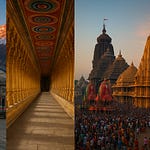Nestled amidst the serene and picturesque landscapes of Pahalgam in the Anantnag district of Jammu and Kashmir, Mamleshwar Mandir stands as a timeless testament to India's ancient spiritual legacy. Dedicated to Lord Shiva, this ancient temple holds deep mythological significance, linking it to the Amarnath Yatra and the sacred legends of Hinduism. Despite its modest size, the temple's aura of divinity, its historical roots, and its peaceful surroundings make it a profound destination for pilgrims and seekers alike.
History and Origin
The Mamleshwar Mandir dates back to the 8th century and is believed to have been built during the reign of King Jayasimha or even earlier. The name "Mamleshwar" is derived from the Sanskrit words:
"Mam" meaning mine and
"Ishwar" meaning God or Lord.
Thus, Mamleshwar translates to "My God," emphasizing the deep personal devotion of devotees towards Lord Shiva.
According to local lore and Puranic texts, Pahalgam (meaning 'the village of shepherds') was the place where Lord Shiva left his Nandi (bull) before proceeding toward the sacred Amarnath Cave to disclose the secret of immortality to Goddess Parvati.
The Mamleshwar Temple is said to be the place where Lord Shiva entrusted the moon from his matted hair (Chandra) before his final journey to Amarnath.
Foundation and Patronage
The temple was constructed using traditional Kashmiri architecture, showcasing the sophisticated skills of the artisans of that era. It is considered one of the earliest shrines of Lord Shiva in the Kashmir Valley, emphasizing the cultural integration of Shaivism (Shiva worship) in Kashmir's spiritual fabric.
The foundation of the temple is strongly rooted in mythology, and it continued to be revered through the centuries despite political changes and natural challenges.
Architecture
Mamleshwar Mandir represents typical Kashmiri stone temple architecture, characterized by:
Square stone structure built using grey granite slabs.
Sloping roof design resembling Himalayan architecture to withstand snow.
Small sanctum sanctorum (garbhagriha) housing the Shivalinga, crafted from black stone.
A holy spring (Vishnu Pad spring) nearby, revered for its purity and associated legends.
Simple carvings reflecting ancient artistry but devoid of elaborate ornamentation, emphasizing austerity and spiritual focus over grandeur.
The temple surroundings are minimalist, adorned by natural beauty rather than man-made embellishments.
Rituals, Puja, and Aarti
Daily Rituals:
Morning Puja is conducted with the chanting of Vedic hymns, Rudrabhishek, and offering of Bilva (Bel) leaves, flowers, water, and milk to the Shivalinga.
Evening Aarti creates an enchanting spiritual atmosphere, with lamps lit and devotional songs sung in honor of Lord Shiva.
Special Rituals:
During the Amarnath Yatra, special prayers and havans (fire rituals) are conducted, as many pilgrims visit Mamleshwar Mandir before embarking on their onward journey.
Mahashivratri is celebrated with great devotion, attracting many local devotees and pilgrims.
Timings
Opening Time: 6:00 AM
Closing Time: 8:00 PM
Best Time for Darshan: Morning hours during Aarti or early evening.
Seasonal Note: The temple is accessible during the summer months (May to September) as heavy snowfall in winter restricts access.
Spiritual Significance
The spiritual energy of Mamleshwar Mandir is deeply palpable.
It is believed that a visit to Mamleshwar Mandir blesses devotees with mental peace, health, and longevity.
As it is linked with Lord Shiva’s journey toward sharing the secret of immortality (Amrit Vachan) to Goddess Parvati, the temple symbolizes the transition from mortal existence to divine realization.
The holy spring near the temple, known as Vishnu Pad, is considered sacred. It is believed that Lord Vishnu left his footprint here while paying homage to Lord Shiva.
Puranic Importance
The Shiva Purana and Kashmir Puranas allude to Pahalgam as a resting place of Lord Shiva.
Before proceeding to Amarnath Cave, Shiva left behind various symbols of his powers — starting from Nandi at Pahalgam (Mamleshwar), Moon at Chandanwari, snakes at Sheshnag, Ganga at Panchtarni, and finally his earthly form at Amarnath.
Thus, Mamleshwar Mandir is considered the first step in the Amarnath pilgrimage, both physically and spiritually.
Specialities of Mamleshwar Mandir
Ancient Stone Shiva Lingam: The Shivling inside the temple is believed to be self-manifested (Swayambhu).
Holy Spring: A sacred spring adjacent to the temple, believed to have healing and purifying properties.
First Pilgrimage Halt: It is the spiritual first step in the Amarnath Yatra sequence.
Atmosphere: The tranquil setting amidst tall pines and deodar forests amplifies the spiritual experience.
Travel Guide
How to Reach Mamleshwar Mandir:
Nearest Airport: Srinagar Airport (approx. 95 km from Pahalgam)
Nearest Railway Station: Jammu Tawi Railway Station (approx. 255 km)
By Road:
From Srinagar: Taxis and buses are available to Pahalgam.
From Jammu: Regular bus and taxi services available.
Local Transport:
From Pahalgam town center, Mamleshwar Temple is just about 1.5 km, reachable via a short scenic walk or a pony ride.
Nearby Attractions
Aru Valley: 12 km from Pahalgam, a picturesque valley known for lush meadows and starting point for treks.
Betaab Valley: 15 km, named after Bollywood movie "Betaab"; famous for its stunning beauty.
Chandanwari: Starting point of the Amarnath Yatra, around 16 km away.
Lidder River: Flows nearby, ideal for picnics and short river walks.
Baisaran (Mini-Switzerland): 5 km trek from Pahalgam, known for meadows and panoramic views.
Best Time to Visit
Summer (May to September): Pleasant weather and accessible roads.
Amarnath Yatra Season (July-August): For a spiritually enriching experience.
Avoid winter months (November to March) due to heavy snowfall and accessibility issues.
Mamleshwar Mandir is not just a temple but a sacred spiritual portal connecting devotees to the deep mythological past of India. Visiting it offers a glimpse into the divine journey of Lord Shiva and serves as an enriching spiritual and cultural experience. The gentle gurgle of the Lidder river, the peaceful surroundings of tall pines, and the timeless aura of the stone shrine make Mamleshwar an unmissable stop for pilgrims, history lovers, and nature enthusiasts alike.
In the embrace of Kashmir's mystical beauty, Mamleshwar Mandir stands serene — a silent witness to centuries of devotion, prayers, and faith.










